Abstract
The metabolic effects of the hypoglycaemic agent pent-4-enoate were studied in isolated, beating or potassium-arrested rat hearts. The addition of 0.8mM-pent-4-enoate to the perfusion fluid increased O2 consumption by 76% in the arrested heart and by 14% in the beating heart; the concentration ratio of phosphocreatine/creatine increase concomitantly by 47% and 27% respectively. Perfusion of the heart with pent-4-enoate resulted in a 30-fold increase in the concentration of the pool of tricarboxylic acid-cycle intermediates in the tissue, about 90% of this increase being due to malate. The sum of the concentrations of the myocardial free amino acids remained virtually unchanged during the accumulation of the tricarboxylic acid-cycle intermediates. It was concluded that pent-4-enoate can be effectively metabolized in the myocardium and that its metabolism probably proceeds via propionyl-CoA, since pent-4-enoate reproduces many of the metabolic characteristics of propionate in the cardiac muscle. The accumulation of the tricarboxylic acid-cycle intermediates is probably due to carboxylation of propionyl-CoA. The response pattern of the metabolite concentrations in the cardiac muscle is quite different from that in the liver, in which decrease of the concentrations of the tricarboxylic acid-cycle intermediates has been observed previously [Williamson, Rostand & Peterson (1970) J. Biol. Chem. 245, 3242-3251].
Full text
PDF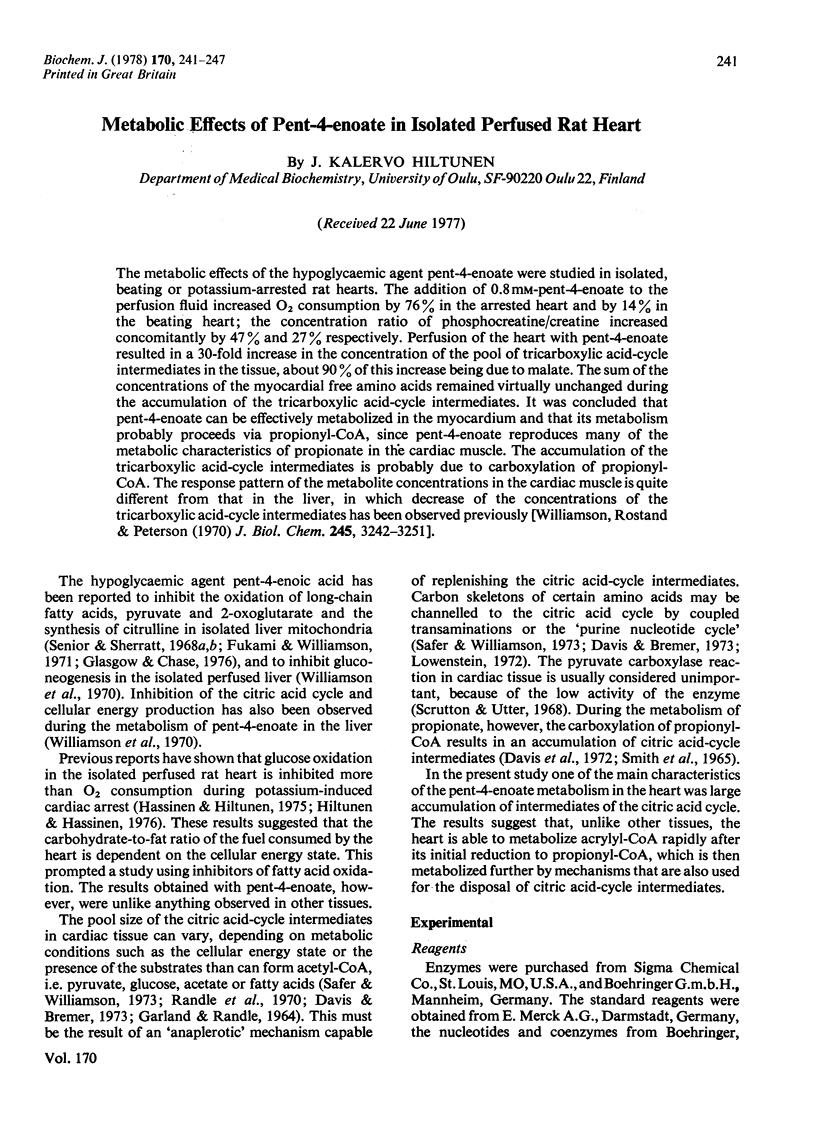
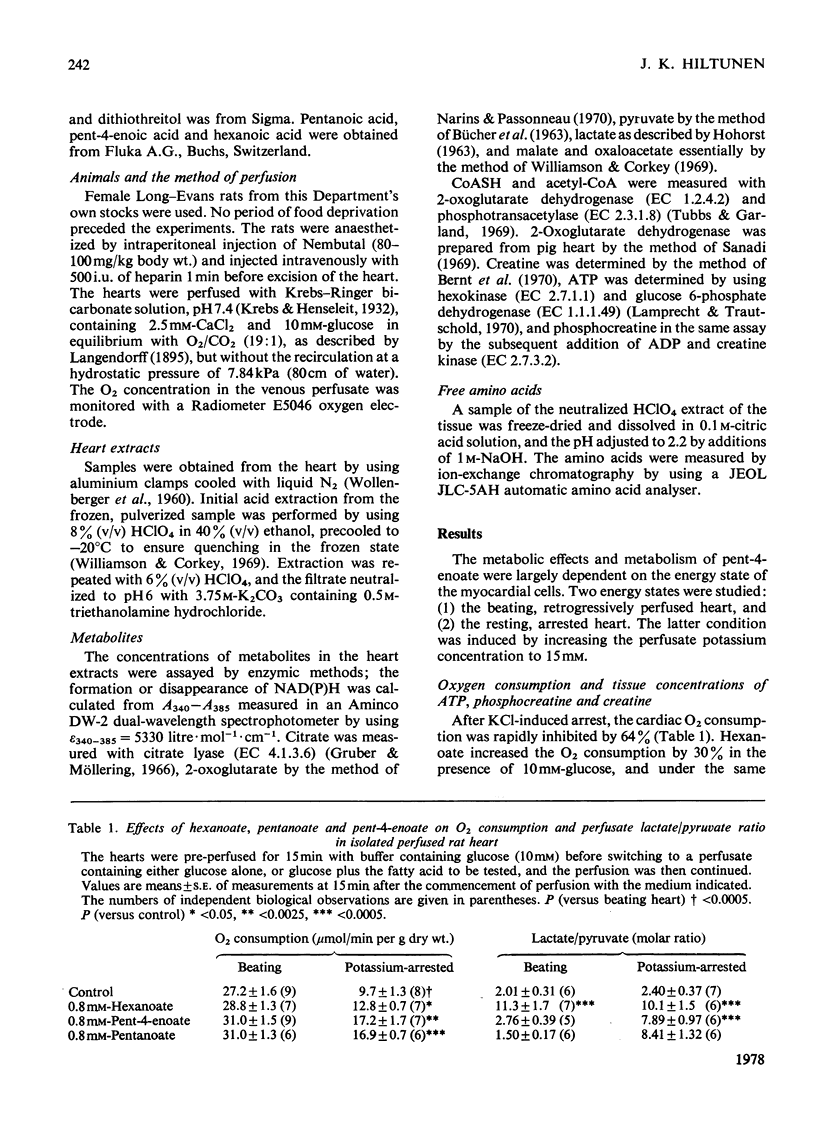

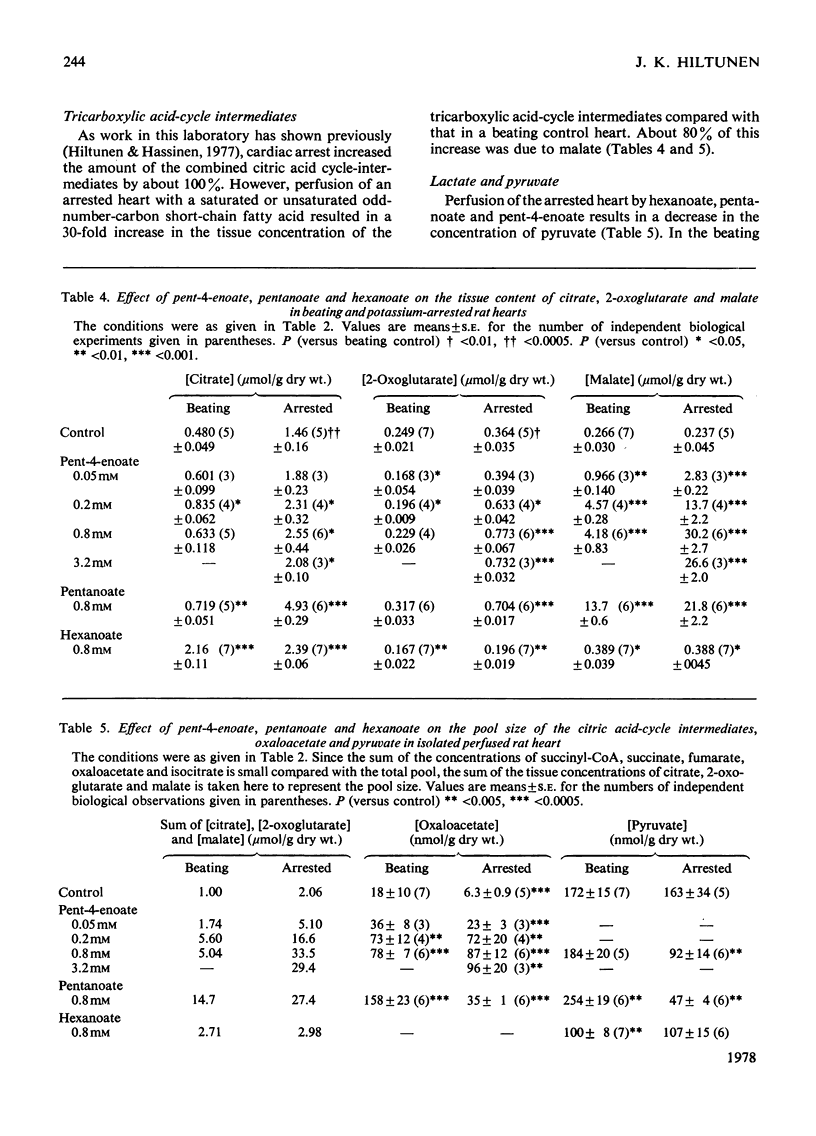
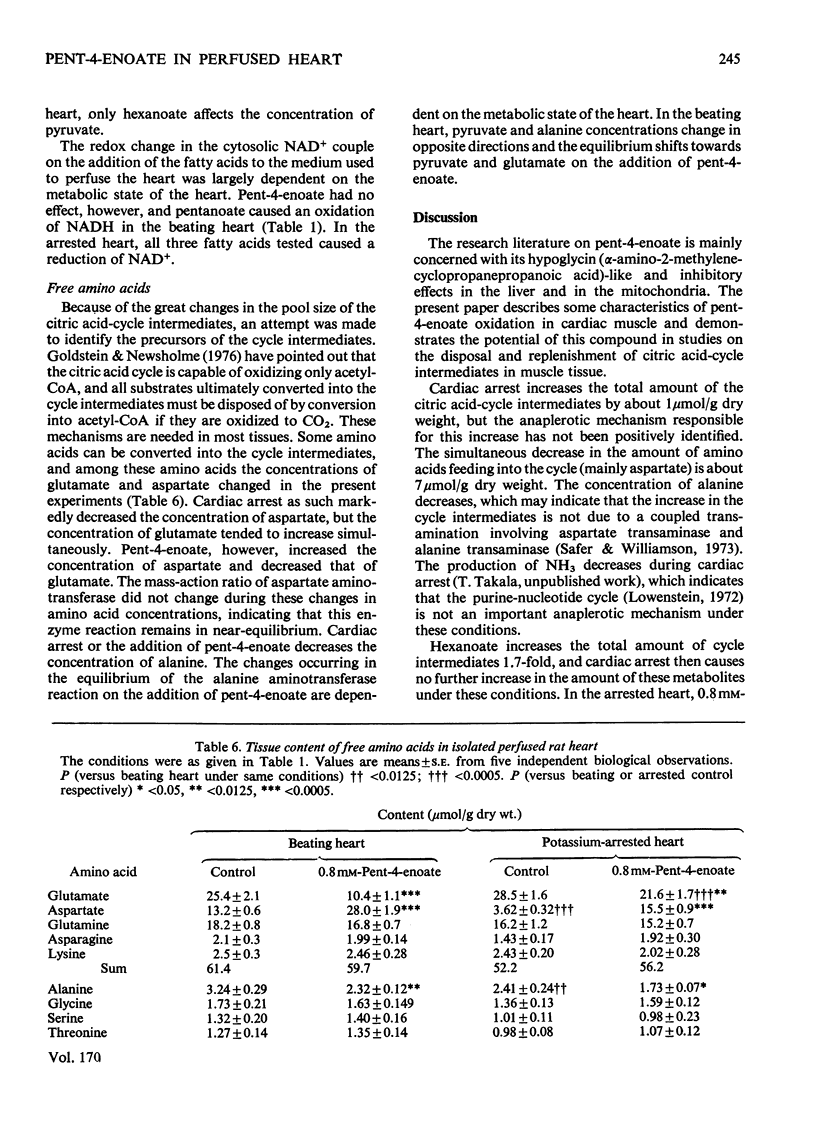
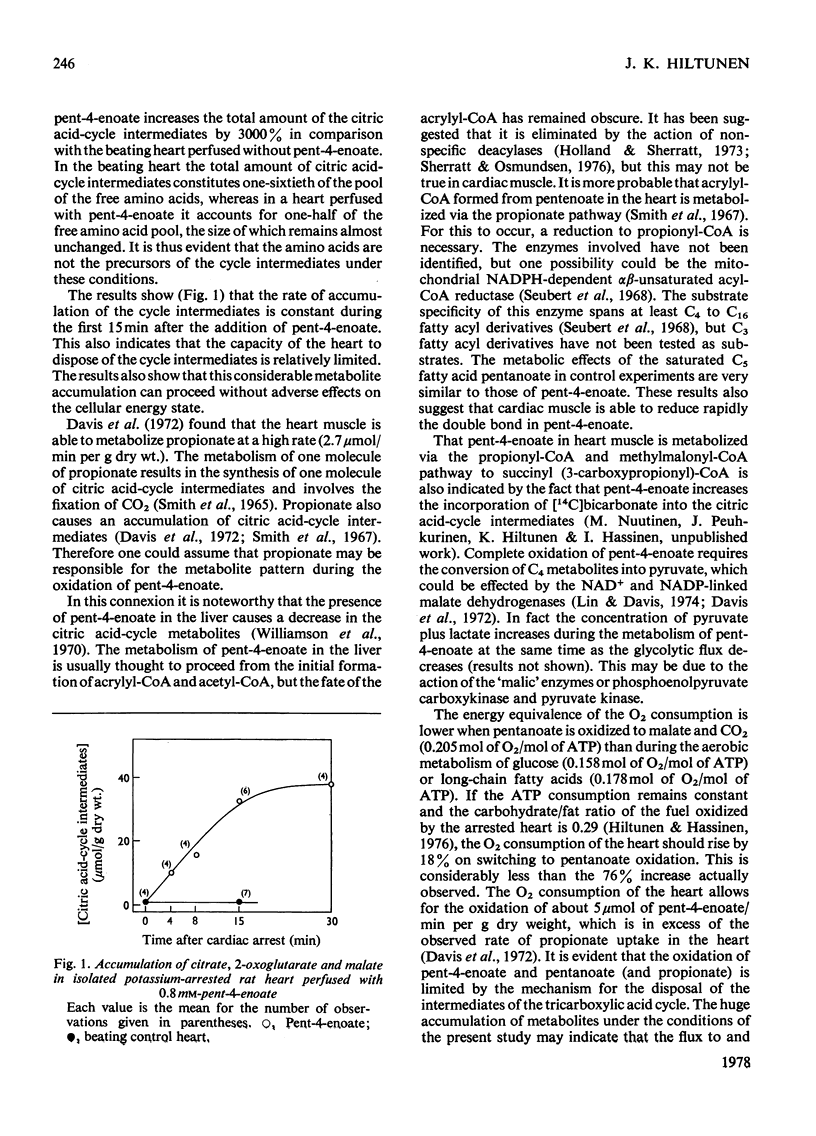
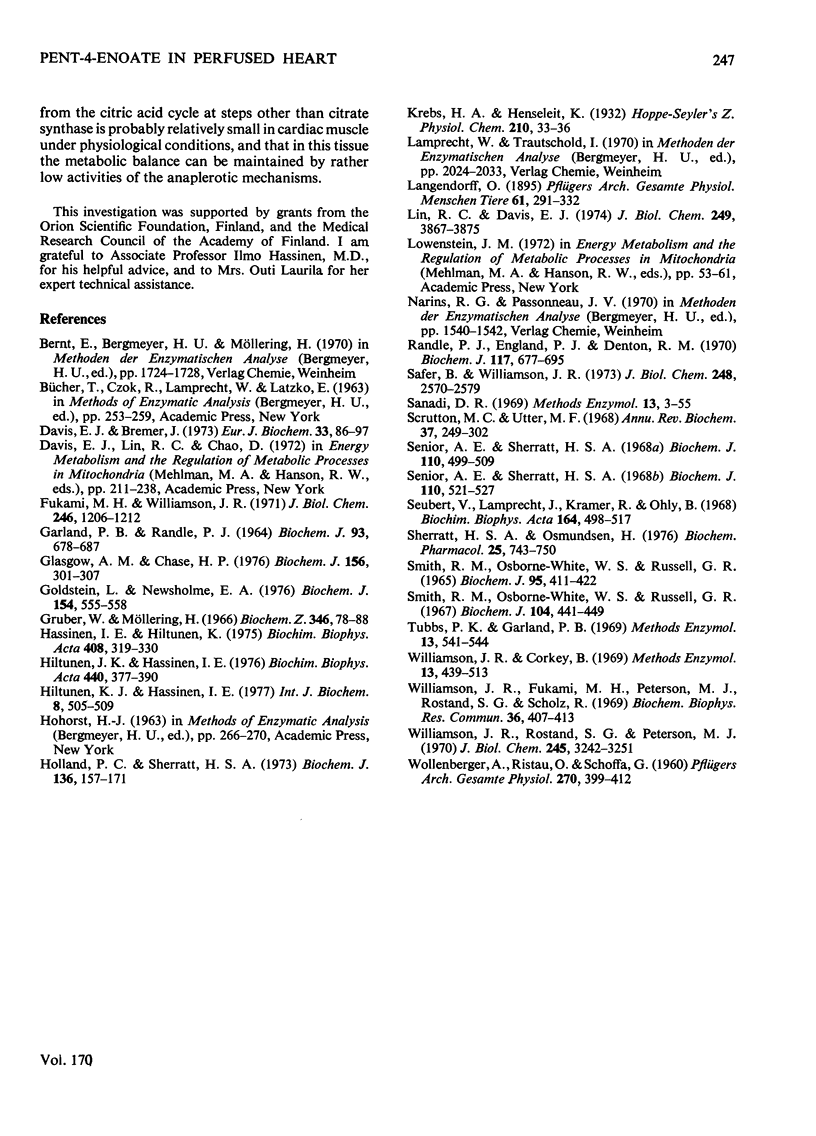
Selected References
These references are in PubMed. This may not be the complete list of references from this article.
- Davis E. J., Bremer J. Studies with isolated surviving rat hearts. Interdependence of free amino acids and citric-acid-cycle intermediates. Eur J Biochem. 1973 Sep 21;38(1):86–97. doi: 10.1111/j.1432-1033.1973.tb03037.x. [DOI] [PubMed] [Google Scholar]
- Fukami M. H., Williamson J. R. On the mechanism of inhibition of fatty acid oxidation by 4-pentenoic acid in rat liver mitochondria. J Biol Chem. 1971 Mar 10;246(5):1206–1212. [PubMed] [Google Scholar]
- Garland P. B., Randle P. J. Regulation of glucose uptake by muscles. 10. Effects of alloxan-diabetes, starvation, hypophysectomy and adrenalectomy, and of fatty acids, ketone bodies and pyruvate, on the glycerol output and concentrations of free fatty acids, long-chain fatty acyl-coenzyme A, glycerol phosphate and citrate-cycle intermediates in rat heart and diaphragm muscles. Biochem J. 1964 Dec;93(3):678–687. doi: 10.1042/bj0930678. [DOI] [PMC free article] [PubMed] [Google Scholar]
- Glasgow A. M., Chase H. P. Effect of pent-4-enoic acid, propionic acid and other short-chain fatty acids on citrulline synthesis in rat liver mitochondria. Biochem J. 1976 May 15;156(2):301–307. doi: 10.1042/bj1560301. [DOI] [PMC free article] [PubMed] [Google Scholar]
- Goldstein L., Newsholme E. A. The formation of alanine from amino acids in diaphragm muscle of the rat. Biochem J. 1976 Feb 15;154(2):555–558. doi: 10.1042/bj1540555. [DOI] [PMC free article] [PubMed] [Google Scholar]
- Hassinen I. E., Hiltunen K. Respiratory control in isolated perfused rat heart. Role of the equilibrium relations between the mitochondrial electron carriers and the adenylate system. Biochim Biophys Acta. 1975 Dec 11;408(3):319–330. doi: 10.1016/0005-2728(75)90133-4. [DOI] [PubMed] [Google Scholar]
- Hiltunen J. K., Hassinen I. E. Energy-linked regulation of glucose and pyruvate oxidation in isolated perfused rat heart. Role of pyruvate dehydrogenase. Biochim Biophys Acta. 1976 Aug 13;440(2):377–390. doi: 10.1016/0005-2728(76)90072-4. [DOI] [PubMed] [Google Scholar]
- Holland P. C., Sherratt H. S. Biochemical effects of the hypoglycaemic compound pent-4-enoic acid and related non-hypoglycaemic fatty acids. Effects of the free acids and their carnitine esters on coenzyme A-dependent oxidations in rat liver mitochondria. Biochem J. 1973 Sep;136(1):157–171. doi: 10.1042/bj1360157. [DOI] [PMC free article] [PubMed] [Google Scholar]
- Lin R. C., Davis E. J. Malic enzymes of rabbit heart mitochondria. Separation and comparison of some characteristics of a nicotinamide adenine dinucleotide-preferring and a nicotinamide adenine dinucleotide phosphate-specific enzyme. J Biol Chem. 1974 Jun 25;249(12):3867–3875. [PubMed] [Google Scholar]
- Randle P. J., England P. J., Denton R. M. Control of the tricarboxylate cycle and its interactions with glycolysis during acetate utilization in rat heart. Biochem J. 1970 May;117(4):677–695. doi: 10.1042/bj1170677. [DOI] [PMC free article] [PubMed] [Google Scholar]
- SMITH R. M., OSBORNE-WHITE W. S. METABOLISM OF PROPIONATE BY SHEEP LIVER. OXIDATION OF PROPIONATE BY HOMOGENATES. Biochem J. 1965 May;95:411–422. doi: 10.1042/bj0950411. [DOI] [PMC free article] [PubMed] [Google Scholar]
- Safer B., Williamson J. R. Mitochondrial-cytosolic interactions in perfused rat heart. Role of coupled transamination in repletion of citric acid cycle intermediates. J Biol Chem. 1973 Apr 10;248(7):2570–2579. [PubMed] [Google Scholar]
- Senior A. E., Sherratt H. S. Biochemical effects of the hypoglycaemic compound pent-4-enoic acid and related non-hypoglycaemic fatty acids. Carbohydrate metabolism. Biochem J. 1968 Dec;110(3):521–527. doi: 10.1042/bj1100521. [DOI] [PMC free article] [PubMed] [Google Scholar]
- Senior A. E., Sherratt H. S. Biochemical effects of the hypoglycaemic compound pent-4-enoic acid and related non-hypoglycaemic fatty acids. Oxidative phosphorylation and mitochondrial oxidation of pyruvate, 3-hydroxybutyrate and tricarboxylic acid-cycle intermediates. Biochem J. 1968 Dec;110(3):499–509. doi: 10.1042/bj1100499. [DOI] [PMC free article] [PubMed] [Google Scholar]
- Seubert W., Lamberts I., Kramer R., Ohly B. On the mechanism of malonyl-CoA-independent fatty acid synthesis. I. The mechanism of elongation of long-chain fatty acids by acetyl-CoA. Biochim Biophys Acta. 1968 Dec 18;164(3):498–517. doi: 10.1016/0005-2760(68)90180-x. [DOI] [PubMed] [Google Scholar]
- Smith R. M., Osborne-White W. S., Russell G. R. Metabolism of propionate by sheep liver. Pathway of propionate metabolism in aged homogenate and mitochondria. Biochem J. 1967 Aug;104(2):441–449. doi: 10.1042/bj1040441. [DOI] [PMC free article] [PubMed] [Google Scholar]
- Stanley H., Sherratt A., Osmundsen H. On the mechanisms of some pharmacological actions of the hypoglycaemic toxins hypoglycin and pent-4-enoic acid. A way out of the present confusion. Biochem Pharmacol. 1976 Apr 1;25(7):743–750. doi: 10.1016/0006-2952(76)90139-8. [DOI] [PubMed] [Google Scholar]
- WOLLENBERGER A., RISTAU O., SCHOFFA G. [A simple technic for extremely rapid freezing of large pieces of tissue]. Pflugers Arch Gesamte Physiol Menschen Tiere. 1960;270:399–412. [PubMed] [Google Scholar]
- Williamson J. R., Fukami M. H., Peterson M. J., Rostand S. G., Scholz R. Effect of 4-pentenoic acid on coenzyme A metabolites in rat liver. Biochem Biophys Res Commun. 1969 Aug 7;36(3):407–413. doi: 10.1016/0006-291x(69)90579-8. [DOI] [PubMed] [Google Scholar]
- Williamson J. R., Rostand S. G., Peterson M. J. Control factors affecting gluconeogenesis in perfused rat liver. Effects of 4-pentenoic acid. J Biol Chem. 1970 Jun;245(12):3242–3251. [PubMed] [Google Scholar]


